16.24.070 Building and landscape frontage.
A. Overview of Building and Landscape Frontage Types. Refer to the Regulating Plan and the development standards tables to determine which building and landscape frontage types are permitted along each street. Each street-facing build-to line shall comply with the development standards listed under the applicable building and landscape frontage type.
1. Linear Building Frontage. A linear building frontage, as set out in Figure 16.24.070-1, is characterized by a facade that is built up to the build-to line. The building entrance is at sidewalk grade, except where there are ground floor residential uses. Linear building frontages have substantial glazing on the ground floor, and often provide awnings or canopies cantilevered over the sidewalk. Building entries must either provide a canopy or awning and/or be recessed behind the front building facade.
2. Forecourt Building Frontage. A forecourt building frontage, as set out in Figure 16.24.070-2, may be created by recessing a portion of the facade for a portion of the building frontage. The forecourt building frontage should be used in conjunction with the linear building frontage. A forecourt building frontage is suitable for commercial or residential uses. A forecourt building frontage may be suitable for gardens and/or outdoor seating.
3. Porch/Stoop/Terrace Building Frontage. The porch-stoop-terrace building frontage, as set out in Figure 16.24.070-3, is characterized by a facade which is set behind the build-to line and a building entry threshold, such as a porch or terrace, set between the building and the build-to line. The threshold may be elevated above or sunken below grade. The building entry is accessed from this threshold. Landscaping may be provided in the setback area between the building and the sidewalk. A porch-stoop-terrace building frontage is suitable for residential uses and service commercial or office uses.
4. Landscape Building Frontage. A landscape building frontage, as set out in Figure 16.24.070-4, is set back from the build-to line by a wide landscaped strip between the building and the sidewalk. This frontage type is appropriate along streets where the existing streetscape may not be conducive to pedestrian-oriented ground floor retail or residential uses, such as where there is no on-street parking or where streets are very wide. Ground floor entries must still be provided along and connected to the sidewalk.
5. Low Wall and Trellis Landscape Frontage. As set out in Figure 16.24.070-5, build-to lines not occupied by buildings, driveways, or pedestrian paths must be screened with a low masonry or concrete wall and overhanging trellis structure.
6. Urban Wall or Fence Landscape Frontage. As set out in Figure 16.24.070-6, build-to lines not occupied by buildings, driveways, or pedestrian paths must be screened with an open framework wall or fence of either metal, wood, masonry, or a combination.
7. Landscape Setback Frontage. As set out in Figure 16.24.070-7, build-to lines not occupied by buildings, driveways, or pedestrian paths must be set back behind a planted landscape area consisting of trees, shrubs, and groundcover plants.
B. General Building and Landscape Frontage Standards.
1. Applicability. The applicable street types or subdistricts are stated at the top of each column. Development on any site adjacent to 6th Avenue, Golf Club Road or Pacific Avenue shall conform to the regulations set out in the relevant column. Development on any site not adjacent to 6th Avenue, Golf Club Road or Pacific Avenue shall conform to the regulations set out in the Urban District, Master Plan District or Pacific Avenue District columns, as applicable.
2. Soil Amendment. All disturbed areas shall be replanted with native and drought-tolerant vegetation and shall meet soil amendment requirements in the current City of Lacey Stormwater Design Manual.
3. Build-to Line.
a. “Build-to line” means the line up to which buildings or landscaping must be constructed. The build-to line may not be the same as the front lot line; see Table 16.24.050-2.
4. Frontage.
a. “Frontage” shall be defined as the linear distance between centerlines of the perpendicular secondary street, other street or through connection, if measuring along a primary street.
b. If on a secondary street, “frontage” shall be defined as the linear distance between centerlines of the perpendicular other street or through connection.
c. All other frontage shall be defined as the linear distance between centerlines of the perpendicular primary street, secondary street, other street or through connection.
d. Where frontage occurs on a curved segment of a street, frontage shall be defined as the linear dimension of the chord.
5. Frontage Requirements.
a. Minimum Building Frontage along Street-Facing Build-to Line. All private and public street- or path-facing build-to lines not occupied by buildings or driveways are required to provide building or landscape frontage between the sidewalk and the remainder of the site.
b. Primary Street Frontage. The primary street frontage shall be defined as the portion of the building facing the street (or the higher order street if on a corner). The front facade of the building shall be built to the primary street frontage build-to line.
c. Secondary Street Frontage. The secondary street frontage shall be defined as the portion of the building facing the lower order street, if on a corner. The front facade of the building shall be built to the secondary street frontage build-to line for a minimum of one hundred feet from the corner or the lot width, whichever is shorter. The building and landscape frontage standards of this section shall apply to the portion of the building that occupies the build-to line for one hundred feet from the corner or the lot width, whichever is shorter.
6. Ground Floor Height Measurement. If a minimum ground floor height is required, with a specific minimum floor to ceiling measurement, the ceiling shall be considered as the bottom of joists, rafters or supporting structure of the roof or floor structural system above; the floor shall be considered as the highest point of any flooring system. The ceiling does not include any non-structural ceiling surface materials such as suspended acoustical tile. Projections such as pendant lighting, exposed mechanical ducting, exposed electrical or communication raceways, or the bottom chord of structural trusses may extend below the ceiling and shall not be included in the floor to ceiling measurement.
Figure 16.24.070-1. Building and Landscaping Frontage Type 1--Linear
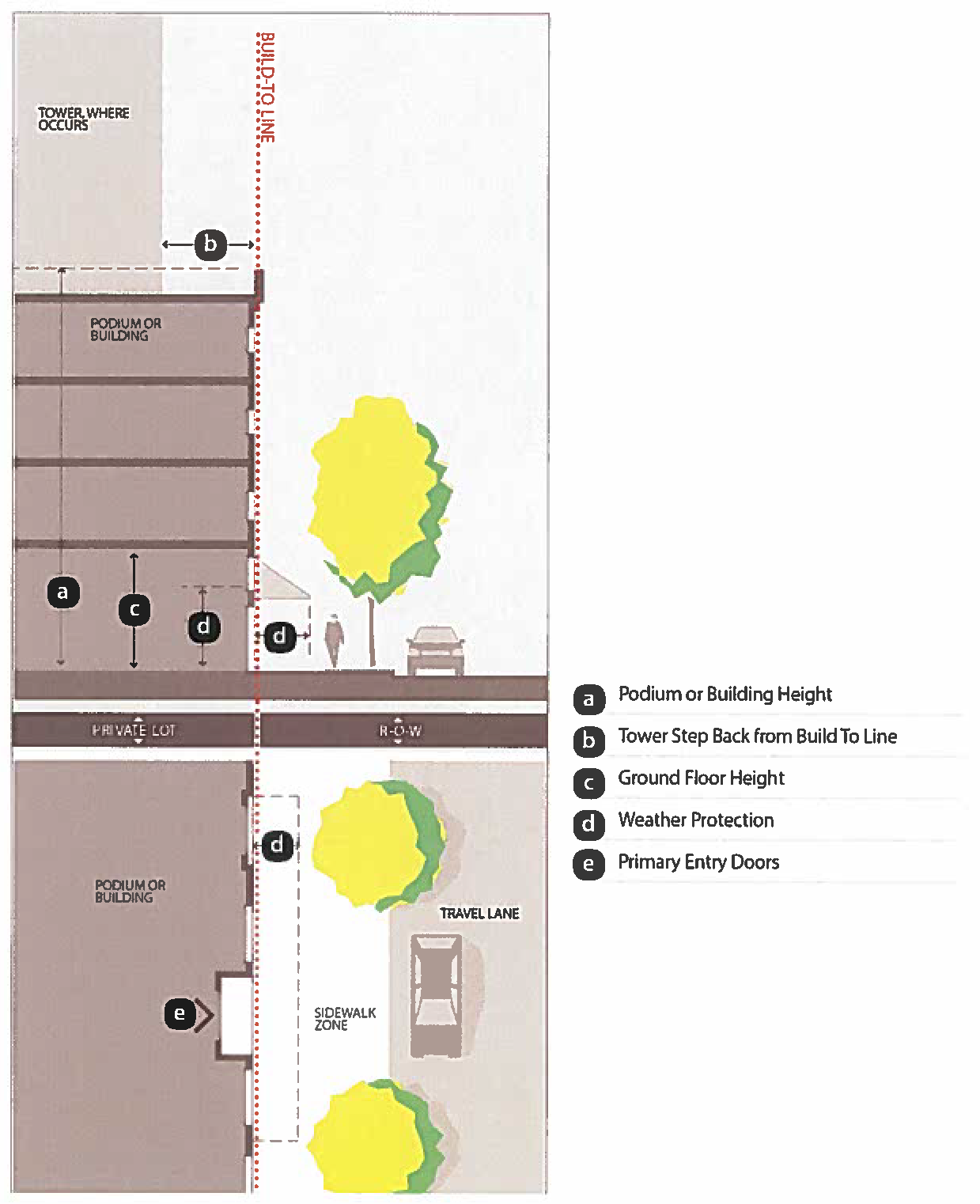
|
Development Standard |
Woodland Square |
Master Plan Area |
6th Ave |
Golf Club Rd |
Pacific Ave District |
Pacific Ave |
|
|---|---|---|---|---|---|---|---|

|
Min. 30 feet |
Min. 20 feet |
|||||
|
Maximum Podium Height |
Max. 55 feet |
||||||
|
Podium Setback from Build-To Line |
Max. 10 feet |
Max. 0 feet |
Max. 10 feet |
Max. 10 feet |
|||
|
Min. 0 feet |
Min. 0 feet |
Min. 5 feet |
Min. 0 feet |
||||

|
Min. 10 feet |
||||||
|
On through block connections: 10 feet minimum |
|||||||
|
Intermediate step back of 15 feet is required at a height of between 0 feet and 20 feet |
|||||||
|
Tower Height |
See Regulating Plan for building heights |
||||||

|
Ground Floor Height |
Min. 18 feet |
|||||
|
Ground Floor Depth |
Min. 40 feet |
||||||
|
Vegetated roofs with public access can be counted towards open space and utility screening requirements. |
|||||||
|
Separation of Ground Floor Residential Uses |
Vertical distance from ground: Min. 18 inches/Max. 3 feet |
||||||
|
Horizontal distance from build-to line: Min. 3 feet/Max. 15 feet |
|||||||

|
Weather Protection |
Protected area: 50 square feet, min.; 5 feet min. horizontal dimension; 10 foot vertical clearance, min. |
No requirement |
Protected area: 50 square feet, minimum; 5 feet min. horizontal dimension; 10 foot vertical clearance, minimum |
|||

|
Primary Entry Doors |
Shall face street; 40% transparent min. |
|||||
|
Windows |
60% min. Required window areas shall allow views from the building to the street. Reflective, dark, tinted or textured glass is not permitted. |
||||||
Figure 16.24.070-2. Building and Landscaping Frontage Type 2--Forecourt
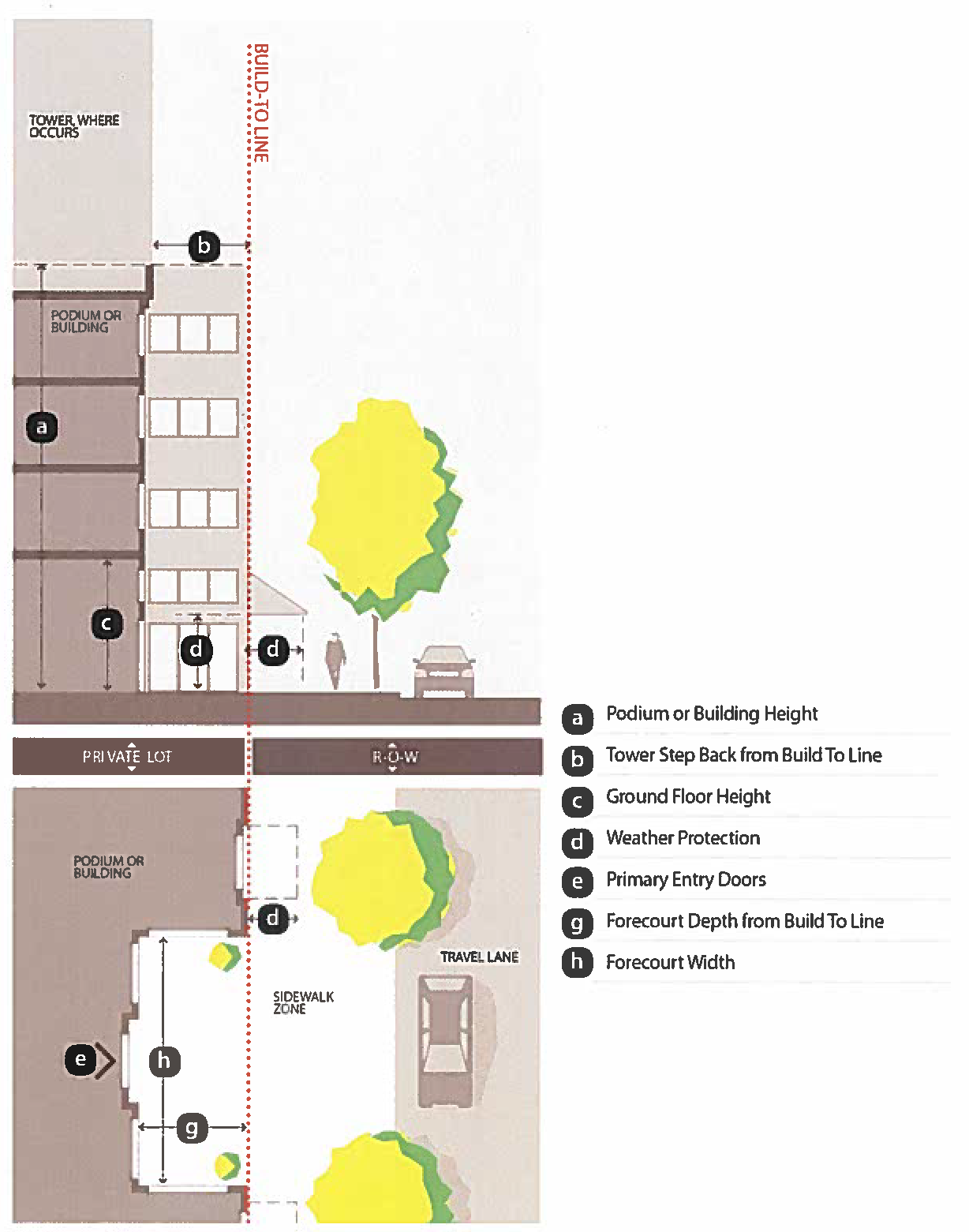
|
Development Standard |
Woodland Square |
Master Plan Area |
6th Ave |
Golf Club Rd |
Pacific District |
Pacific Ave |
|
|---|---|---|---|---|---|---|---|

|
Min. 30 feet |
Min. 20 feet |
|||||
|
Maximum Podium Height |
Max. 55 feet |
||||||
|
Podium Setback from Build-To Line |
Max. 10 feet |
Max. 0 feet |
Max. 10 feet |
Max. 10 feet |
|||
|
Min. 0 feet |
Min. 0 feet |
Min. 5 feet |
Min. 0 feet |
||||

|
Min. 10 feet or match |
||||||
|
On through block connections: 10 feet minimum |
|||||||
|
Intermediate step back of 15 feet is required at a height of between 0 feet and 20 feet |
|||||||
|
Tower step back shall match forecourt maximum depth where tower abuts the forecourt |
|||||||
|
Tower Height |
See Regulating Plan for building heights, Figure 16.24.060-1, Regulating Plan, Building Heights |
||||||

|
Ground Floor Height |
Min.18 feet |
|||||
|
Ground Floor Depth |
Min. 40 feet |
||||||
|
Separation of Ground Floor Residential Uses |
Vertical distance from ground: Min. 18 inches/Max. 3 feet |
||||||
|
Horizontal distance from build-to line: Min. 3 feet/Max. 15 feet |
|||||||
|
Vegetated roofs with public access can be counted towards open space and utility screening requirements. |
|||||||
|
Ground Cover and Planting |
Native and drought-tolerant ground cover plants must fully cover the remainder of the landscaped area between the building and the sidewalk. |
||||||

|
Weather Protection |
Protected area: 50 square feet, minimum; 5 feet min. horizontal dimension; 10 foot vertical clearance, minimum |
No requirement |
Protected area: 50 square feet, minimum; 5 feet min. horizontal dimension; 10 foot vertical clearance, minimum |
|||

|
Primary Entry Doors |
Shall face street; 40% transparent min. |
|||||
|
Windows |
60% min. Required window areas shall allow views from the building to the street. Reflective, dark, tinted or textured glass is not permitted. |
||||||

|
Forecourt Depth from Build-to Line |
Setback: 10 feet minimum; 30 feet maximum |
|||||

|
Forecourt Width |
Setback: 10 feet minimum; 30 feet maximum |
|||||
|
The forecourt frontage shall incorporate the linear frontage type for building faces on the primary and secondary street frontages that are not part of the courtyard. |
|||||||
|
Fence |
No greater than 3 feet in height; min. 20% transparent |
||||||
Figure 16.24.070-3. Building and Landscaping Frontage Type 3--Porch-Stoop-Terrace
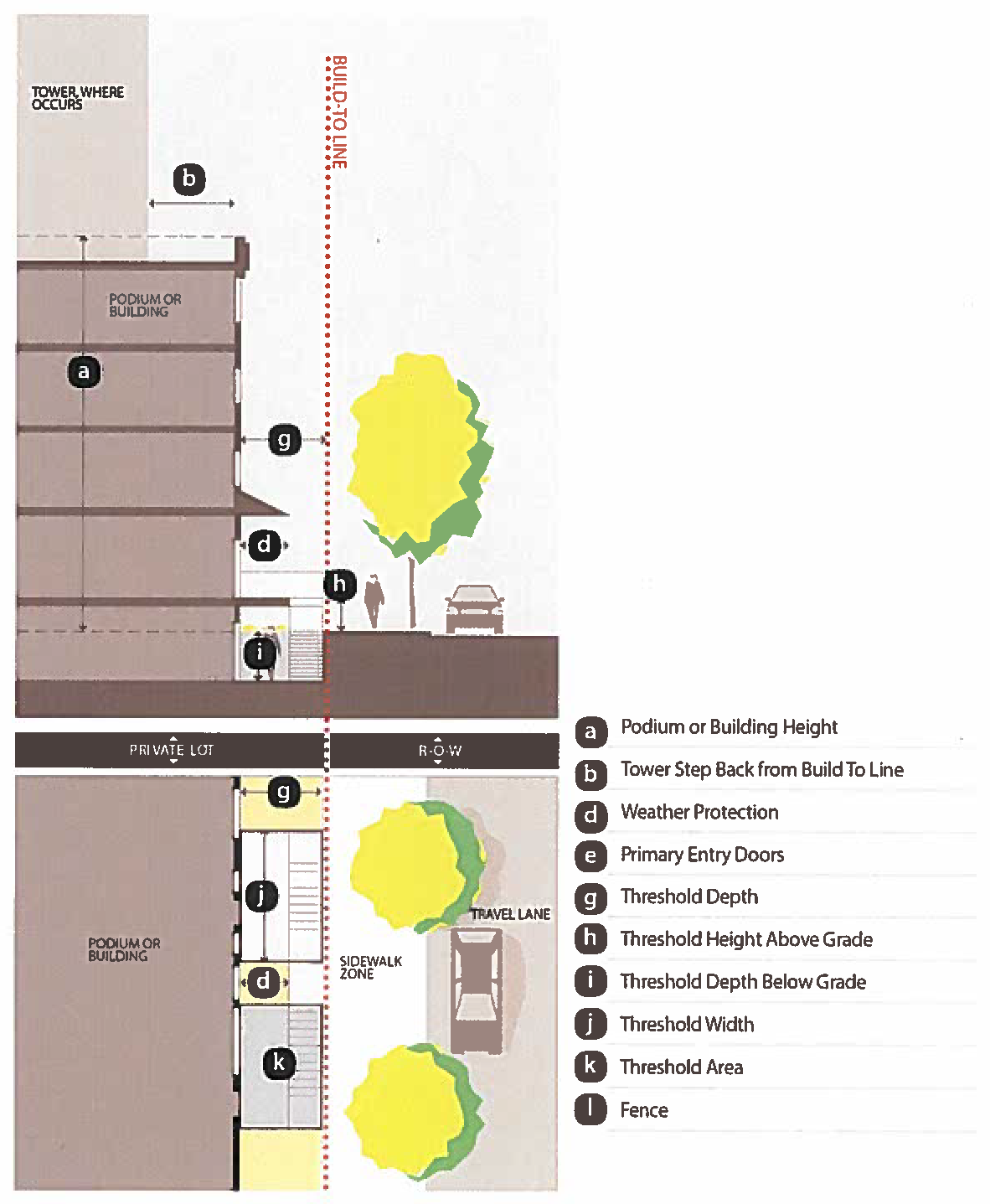
|
Development Standard |
Woodland Square |
Master Plan Area |
6th Ave |
Golf Club Rd |
Pacific District |
Pacific Ave |
|
|---|---|---|---|---|---|---|---|

|
Min. 30 feet |
Min. 20 feet |
|||||
|
Maximum Podium Height |
Max. 55 feet |
||||||
|
Podium Setback from Build-To Line |
Max. 15 feet |
NA |
Max. 15 feet |
||||
|
Min. 5 feet |
Min. 5 feet |
||||||

|
Min. 10 feet |
||||||
|
On through block connections: 10 feet minimum |
|||||||
|
Intermediate step back of 15 feet is required at a height of between 0 feet and 20 feet |
|||||||
|
Tower Height |
See Regulating Plan for Building Heights, Figure 16.24.060-1 Regulating Plan, Building Heights |
||||||

|
Ground Floor Height |
Min. 18 feet |
|||||
|
Ground Floor Depth |
Min. 40 feet |
||||||
|
Separation of Ground Floor Residential Uses |
Vertical distance from ground: Min. 18 inches/Max. 3 feet |
||||||
|
Horizontal distance from build-to line: Min. 3 feet/Max. 15 feet |
|||||||
|
Vegetated roofs with public access can be counted towards open space and utility screening requirements. |
|||||||
|
Ground Cover and Planting |
Native and drought-tolerant ground cover plants must fully cover the remainder of the landscaped area between the building and the sidewalk. |
||||||

|
Weather Protection |
Protected area: 20 square feet, minimum; 5 feet min. horizontal dimension; 10 foot vertical clearance, minimum |
No requirement |
Protected area: 20 square feet, minimum; 5 feet min. horizontal dimension; 10 foot vertical clearance, minimum |
|||

|
Primary Entry Doors |
Shall face street; 20% transparent min. |
|||||
|
Windows |
30% min. Required window areas shall allow views from the building to the street. Reflective, dark, tinted or textured glass is not permitted. |
||||||

|
Threshold Depth |
Min. 4 feet |
|||||

|
Threshold Height Above Grade |
Max. 5 feet |
|||||

|
Threshold Depth Below Grade |
Max. 4 feet |
|||||

|
Threshold Width |
Min. 5 feet |
|||||

|
Threshold Area |
Max. 150 square feet per building entry |
|||||

|
Fences |
No greater than 3 feet in height; min. 20% transparent |
|||||
Figure 16.24.070-4. Building and Landscaping Frontage Type 4--Landscape Building
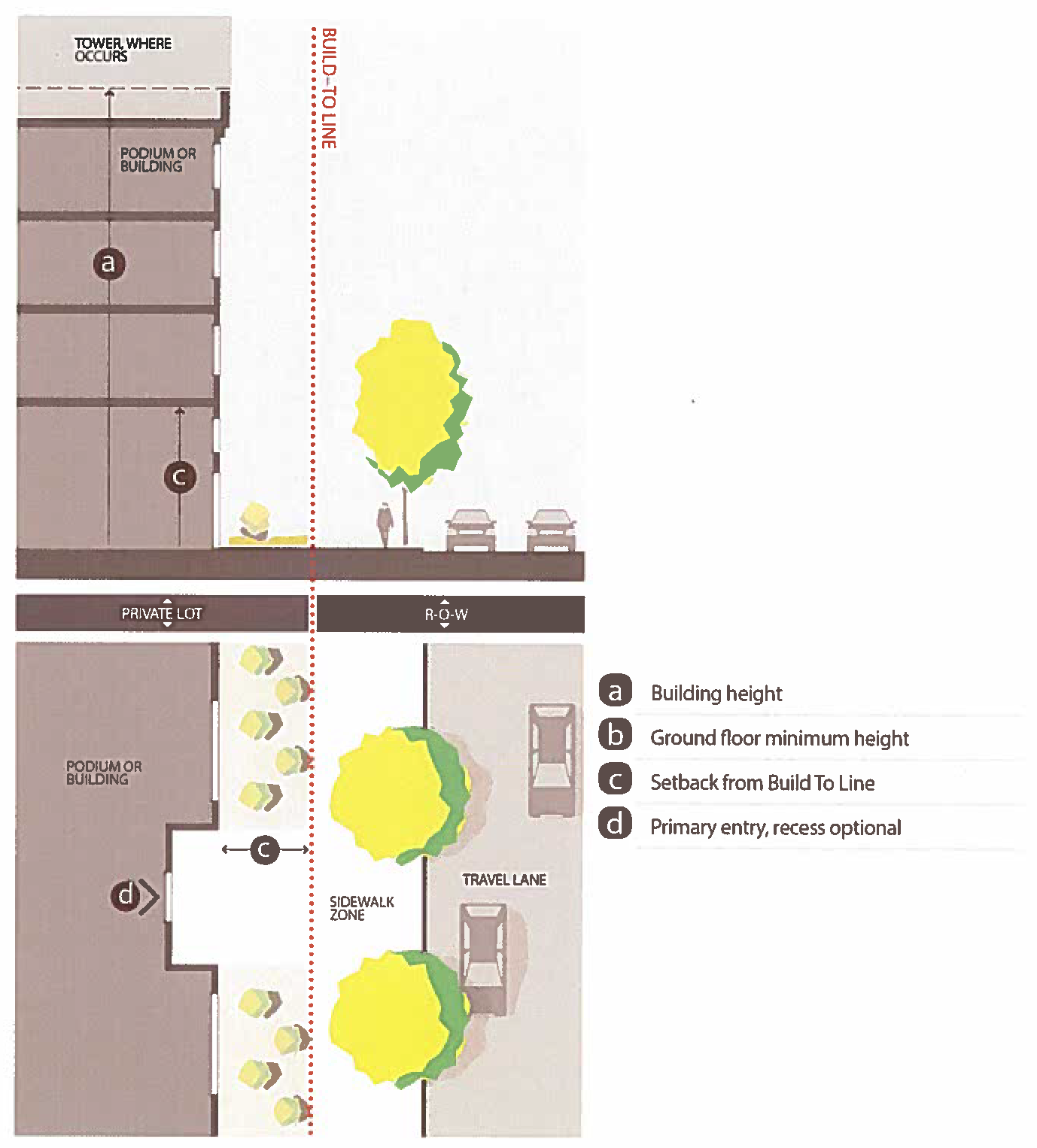
|
Development Standard |
Woodland Square |
Master Plan Area |
Pacific District |
Pacific Ave |
|
|---|---|---|---|---|---|

|
Min. 30 feet |
Min. 20 feet |
|||
|
Maximum Podium Height |
Max. 55 feet |
||||

|
Podium Setback from Build-To Line |
Max. 15 feet |
|||
|
Min. 10 feet |
|||||
|
Min. 10 feet |
|||||
|
On through block connections: 10 feet minimum |
|||||
|
Intermediate step back of 15 feet is required at a height of between 0 feet and 20 feet |
|||||
|
Tower Height |
See Regulating Plan for Building Heights, Figure 16.24.060-1 Regulating Plan, Building Heights |
||||
|
Minimum Building Depth |
Min. 40 feet |
||||
|
Weather Protection |
Building entrances shall be either be covered by an awning or canopy or be covered by being recessed behind the front building facade. If an awning or canopy is provided, it must provide a minimum vertical clearance of 8 feet and a maximum clearance of 15 feet. If only a recessed entry is provided, it must be recessed behind the front facade a minimum of 3 feet and a maximum of 5 feet. |
||||

|
Primary Entry Doors |
At least one building entrance shall be directly connected to the primary or secondary street with a walkway measuring a minimum of 5 feet wide. A minimum of 40% of each primary entry shall be transparent. |
|||
|
Windows |
Transparent ground floor windows must be provided along a minimum of 60% of the ground floor, primary and secondary street-facing facade area. Required window areas shall allow views from the building to the street. Reflective, dark, tinted or textured glass is not permitted. |
||||
|
Service and Utility Equipment |
Building service and utility equipment and outdoor storage of garbage and/or recycling is not permitted along a primary or secondary street or within the required setback from build-to line. |
||||
|
Vegetated roofs with public access can be counted towards open space and utility screening requirements. |
|||||
|
Ground Cover and Planting |
Native and drought-tolerant ground cover plants must fully cover the remainder of the landscaped area between the building and the sidewalk. |
||||
Figure 16.24.070-5. Building and Landscaping Frontage Type 5--Low Wall and Trellis
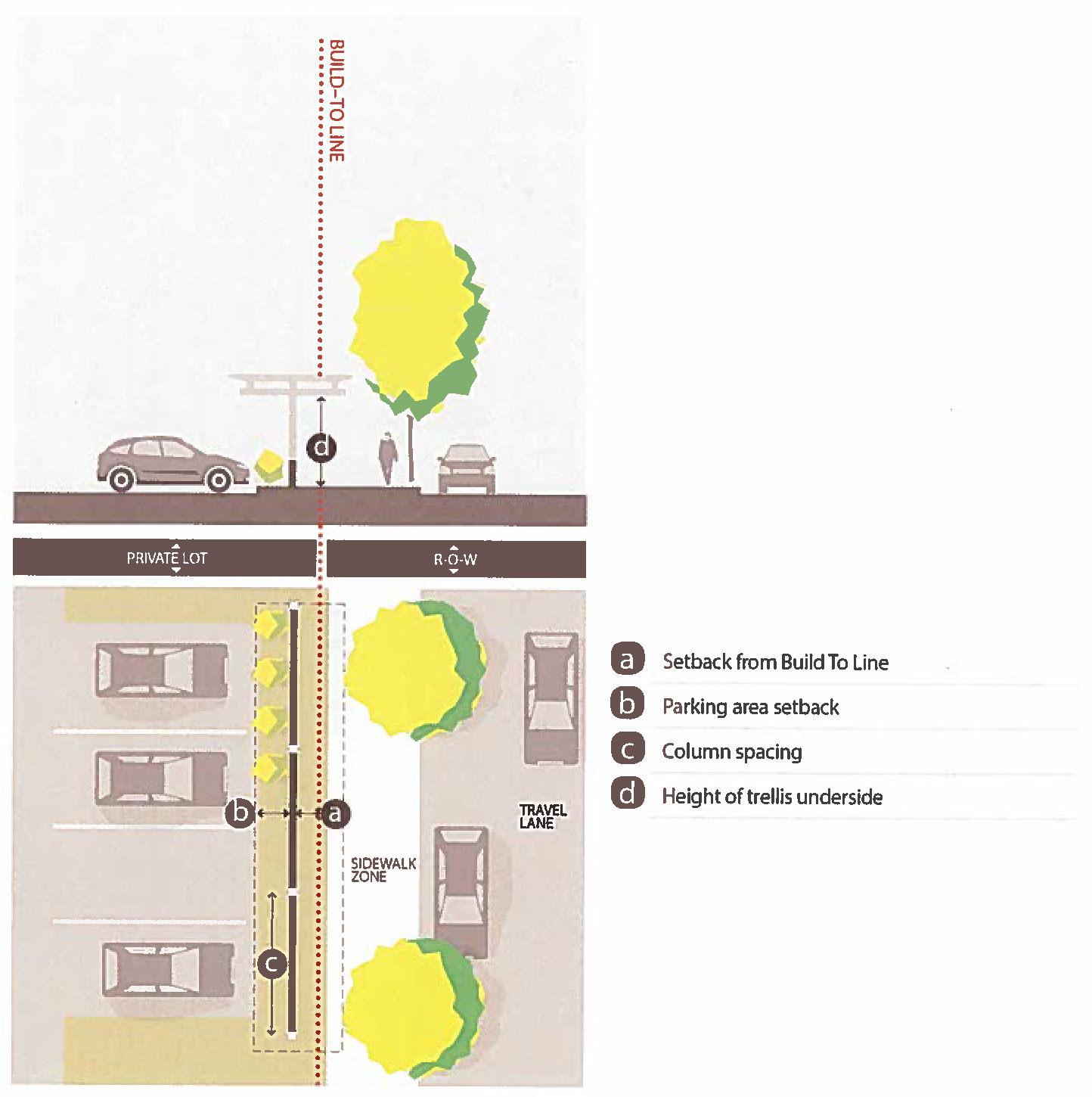
|
Development Standard |
Woodland Square |
Master Plan Area |
6th Ave |
Golf Club Rd |
Pacific District |
Pacific Ave |
|
|---|---|---|---|---|---|---|---|
|
Where specified according to Table 16.24.050-1 (Connections and Connection Spacing) and Table 16.24.050-2 (Overview of Streets and Through Connection Types), surface parking areas shall be screened with a low wall and trellis along the build-to line. |
|||||||

|
Setback from Build-to Line |
The low wall and trellis shall be set back a minimum of 0 feet and a maximum of 5 feet from the build-to line. |
|||||

|
Column Spacing |
The trellis shall have masonry, heavy timber, or steel (or similar metal) supporting columns spaced no more than 30 feet on center. |
|||||

|
Height of Trellis |
The underside of the trellis portion of a low wall and trellis shall be a minimum of 8 feet above grade and a maximum of 14 feet above grade. The trellis shall be heavy timber or steel (or a similar material) and shall consist of open structure with no decking or awning material. |
|||||
|
Low Wall |
The low wall portion of a low wall and trellis shall be a minimum of 1.5 feet and a maximum of 3 feet and have a minimum depth of 1.5 feet. The low wall shall be vegetated wall, wood, masonry, and/or concrete. |
||||||
|
Low Wall Openings |
Openings in the low wall and trellis are allowed for pedestrian pathways, sidewalks, plazas, and driveways. |
||||||

|
Surface Parking Setback |
Surface parking shall be set back a minimum of 3 feet from the low wall and trellis. |
|||||
|
Ground Cover and Planting |
Any setback area between the sidewalk and the wall shall be planted or paved with stamped concrete, permeable pavers, or masonry pavers. |
||||||
|
The setback between the low wall and surface parking shall be planted with native and drought-tolerant low shrubs, groundcover, and climbing plants. Vegetated LID facilities are allowed in the ground cover and planting area. |
|||||||
Figure 16.24.070-6. Building and Landscaping Frontage Type 6--Urban Fence or Wall
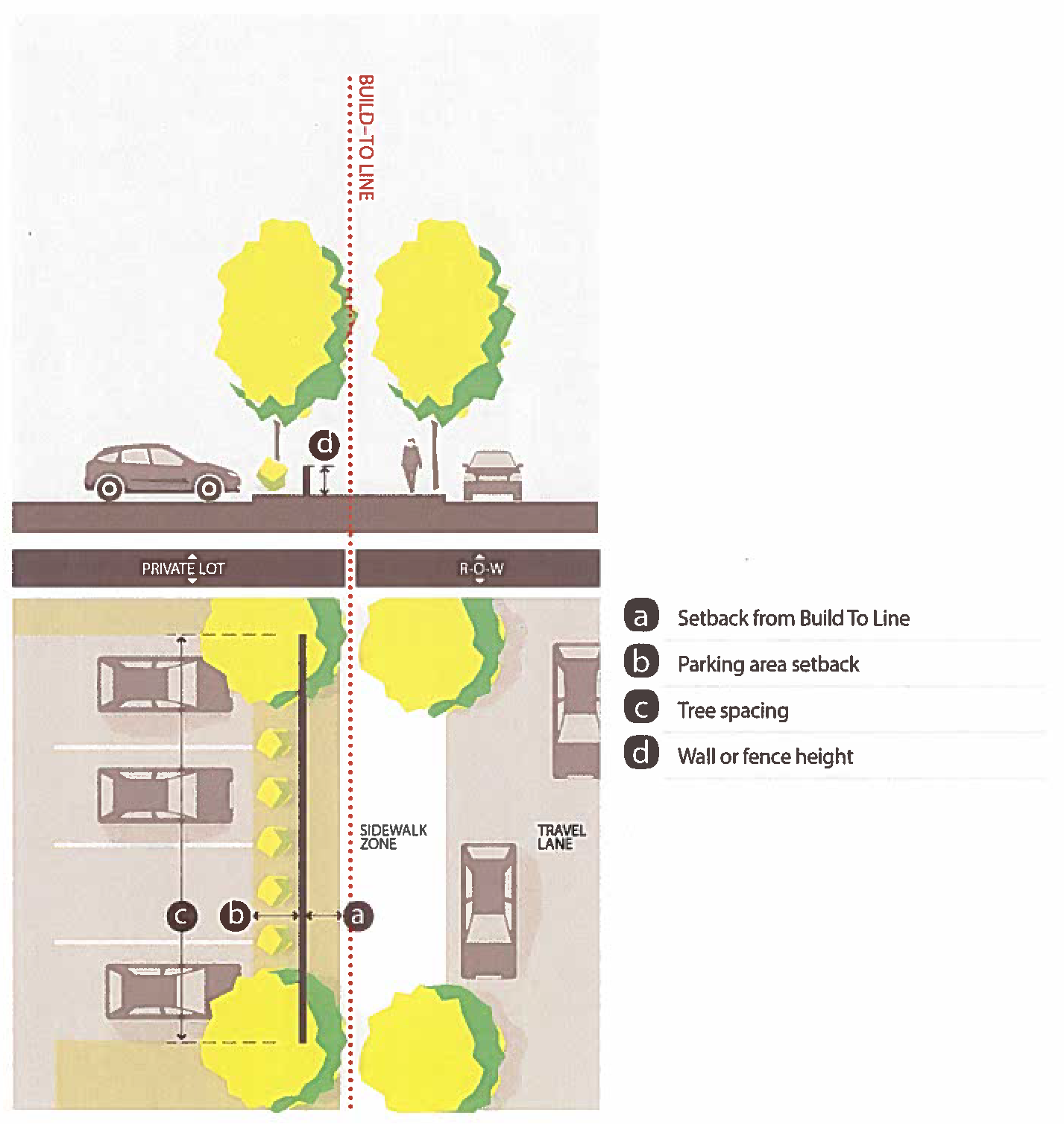
|
Development Standard |
Woodland Square |
Master Plan Area |
6th Ave |
Golf Club Rd |
Pacific District |
Pacific Ave |
|
|---|---|---|---|---|---|---|---|
|
Where specified according to Table 16.24.050-1 (Connections and Connection Spacing) and Table 16.24.050-2 (Overview of Streets and Through Connection Types), surface parking areas shall be screened with an urban fence or wall along the build-to line. |
|||||||

|
Setback from Build-to Line |
The urban fence or wall shall be set back a maximum of 5 feet from the sidewalk. The area between the urban fence or wall shall be hardscaped with either masonry pavers or stamped concrete. |
|||||

|
Wall or Fence Height |
Walls shall be vegetated wall, wood, masonry, and/or concrete; fences shall be made of wrought iron, steel, or a similar material (but not chain-link) and must be dark in color. The fence shall be at least 2 feet high and no more than 3 feet high. Fences may be no more than 50% sight obscuring. The wall shall be at least 2 feet high and no more than 3 feet high above the grade of the sidewalk. |
|||||

|
Tree Spacing |
In addition to the required fence or wall, trees and shrubs shall be provided. One large tree is required every 30 linear feet minimum along all public or private street-facing frontages, except where it is necessary to ensure adequate traffic visibility. The shrubs shall be at least as high as the wall or fence, and shall be no more than 6 feet high. |
|||||
|
Wall or Fence Openings |
Openings in the urban fence or wall are allowed for pedestrian pathways, sidewalks, plazas, and driveways. |
||||||

|
Surface Parking Setback |
The surface parking area shall be set back, at a minimum, an additional 5 feet to provide room for required vegetated LID facilities and/or native and drought-tolerant landscaping. |
|||||
|
Ground Cover and Planting |
Native and drought-tolerant ground cover plants must fully cover any remaining landscaped area between the parking area and the urban fence or wall. Vegetated LID facilities are allowed in the ground cover and planting area. |
||||||
Figure 16.24.070-7. Building and Landscaping Frontage Type 7--Landscape Setback
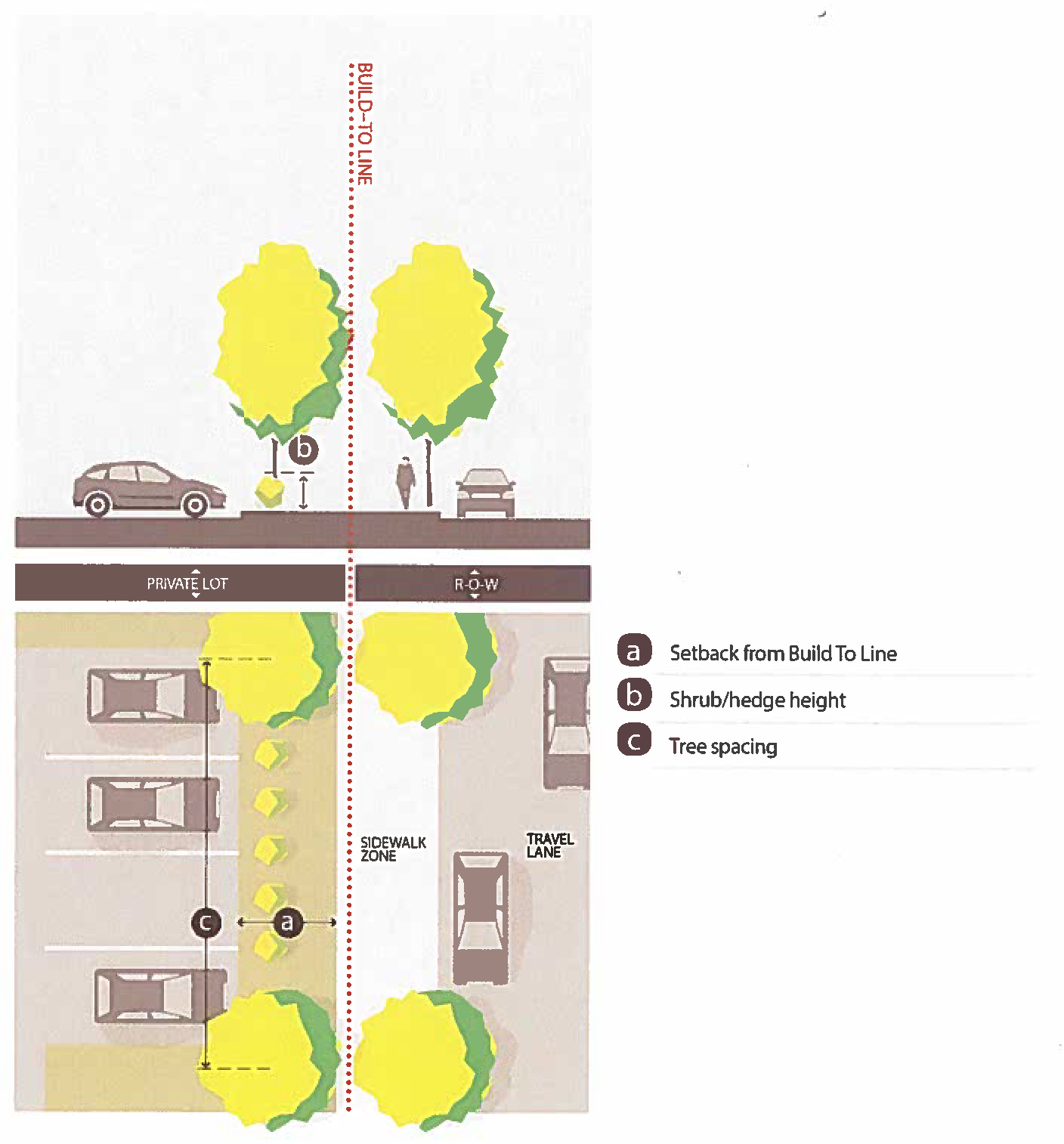
|
Development Standard |
Woodland Square |
Master Plan Area |
Pacific District |
Pacific Ave |
|
|---|---|---|---|---|---|
|
Where specified according to Table 16.24.050-1 (Connections and Connection Spacing) and Table 16.24.050-2 (Overview of Streets and Through Connection Types), surface parking areas shall be screened with a landscape setback along the build-to line. |
|||||

|
Setback from Build-to Line |
Along all public or private street-facing frontages, surface parking shall be set back a minimum of 10 feet behind the build-to line. |
|||

|
Shrub and Hedge Height |
The surface parking area shall be screened with a continuous row of hedges or shrubs immediately adjacent to the parking area, except where there is a driveway. The shrubs shall be a minimum of 3 feet high and must be mostly opaque year round. A 3-foot-high masonry wall may be substituted for the shrubs but the trees and groundcover plants are still required. |
|||

|
Landscape Area |
In addition to the required shrubs, one large tree is required every 30 linear feet minimum along all public or private street-facing frontages. The shrubs/hedge shall be interrupted with a gap of up to 2 to 3 feet wide in order to accommodate trees. |
|||
|
Walkways |
Openings in the setback are allowed for pedestrian pathways, sidewalks, plazas, and driveways. |
||||
|
Ground Cover and Planting |
Native and drought-tolerant ground cover plants must fully cover the remainder of the landscaped area between the parking area and the sidewalk. |
||||
(Ord. 1539 §75, 2019; Ord. 1496 §65, 2016; Ord. 1487 §3 (part), 2016).